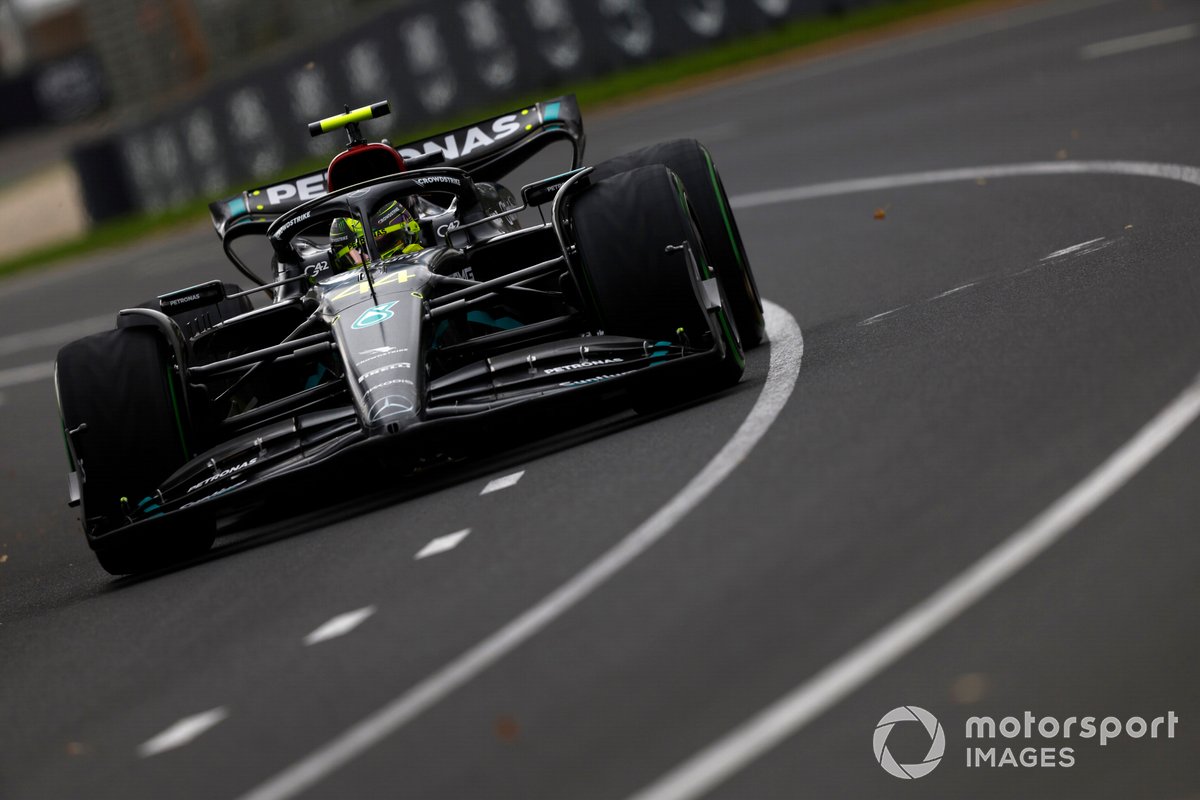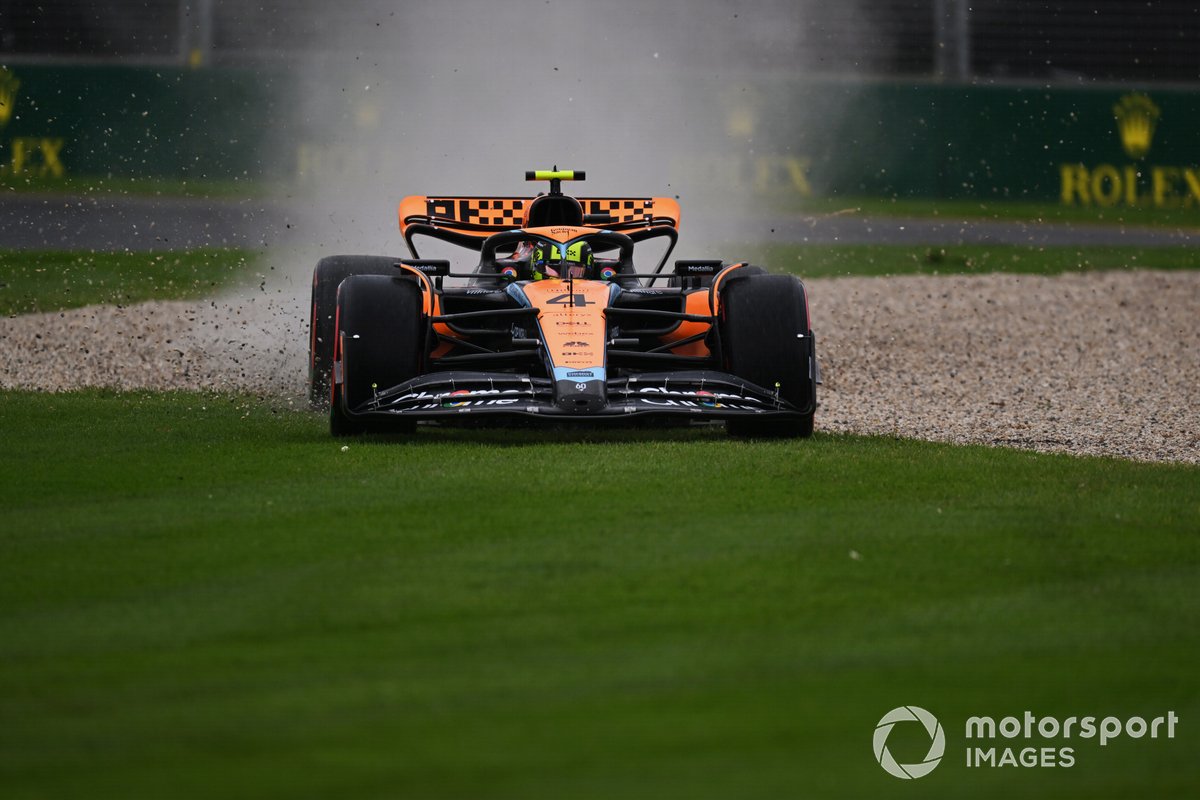
Mixed Melbourne weather and Formula 1 data systems trouble resulted in frustratingly truncated first practice running for the 2023 Australian Grand Prix, where Red Bull led the way but faced rare issues.
Max Verstappen topped the times in FP1, the only fully dry session on Friday at Albert Park, but had off-track moments and a dramatic spin late in the session, while team-mate Sergio Perez also struggled to keep his RB19 on the road.
Rain massively reducing running in FP2 meant the teams missed the usual long-run data-gathering that can help influence race predictions, but nevertheless there was plenty seen (and unseen) at Albert Park that could still impact the rest of the event.
Here’s everything we learned on Friday at the 2023 Australian Grand Prix.
The story of the day
In FP1, the pack had to contend with two invisible factors that set the story of that session. The first was strong wind blowing across the cars as they turned in for the opening corners, which put many drivers off the road or left them catching dramatic oversteer snap as they fought to stay off the kerbs these ground effects cars detest.
Yuki Tsunoda had a spin in these conditions that nearly put his AlphaTauri upside down as it caught the Turns 1/2 gravel trap flying backwards halfway through FP1. This came just after Ferrari’s Carlos Sainz had plunged off the road at the same spot and Verstappen had to catch the rear of his Red Bull stepping badly out of line there. Lewis Hamilton had to rescue the tail end at this complex nearly every lap during his early running.

Then, in FP1’s final third, a problem with a server controlling the distribution of live tyre information triggered a major GPS blackout for the teams. This led to several near-misses between cars on different run plans that were going slowly and quickly at different times, so FP1 was red-flagged for nearly 10 minutes.
Following this temporary stoppage, Verstappen, who led the way in the times with a 1m18.790s set 20 minutes into FP1, had a spin which “rooted that set of tyres”, per Red Bull team boss Christian Horner. This occurred when Verstappen climbed hard onto the kerbs exiting Turn 4 and nearly speared into the track’s inside wall in a manner similar to the incident where Sebastian Vettel crashed out of last year’s race here for Aston Martin.
With a few minutes of FP1 remaining, Logan Sargeant stopping coming out of Turn 11 due to an electrical problem meant the session was cut short. Williams couldn’t fix the American’s problem after this and so he missed the rest of the day’s running.
In FP2, Sainz and Verstappen exchanged early benchmark times at the top of the order before Alonso forged clear on a 1m18.887s – the trio running the medium tyres. Only Perez was running the softs early on, as he hadn’t set a personal best on that rubber in FP1 (where he was 0.503s behind Verstappen using the mediums and had an off going deep in Turn 3 in the latter stages).
The Mexican driver was set to beat Alonso’s best by some margin at the 10-minute mark – he was 0.379s up after a pair of purple sectors – but catching Alfa Romeo’s Zhou Guanyu going slowly at the super-fast Turns 9/10 complex meant Perez had to back off and he later pondered that “it felt like a lot of us still had issues” on the GPS problem. Perez never got to try another flier, as the rain then rolled in and stopped the drivers improving.
Charles Leclerc had just gone second quickest for Ferrari before that and he and Sainz later attempted to complete qualifying simulation runs on the softs a few minutes into the precipitation, but were put off by the slippery, moist surface and headed back to the pits.
There was a flurry of late running on intermediates as the rain got steadily heavier. Both Lance Stroll and George Russell had to catch snaps under acceleration that nearly sent them off track exiting Turn 3. That's where a wall runs close – and was hit in 2011 by then Lotus reserve driver Karun Chandhok in a similarly wet FP1.
But none of the wet-running laps troubled the early established order and so Alonso’s FP2-topping position was preserved.

Overall FP1 order
| Pos | Driver | Team | Time/Gap |
| 1 | Max Verstappen | Red Bull | 1m18.790s |
| 2 | Lewis Hamilton | Mercedes | +0.433s |
| 3 | Fernando Alonso | Aston Martin | +0.527s |
| 4 | Charles Leclerc | Ferrari | +0.588s |
| 5 | Lando Norris | McLaren | +0.746s |
| 6 | Pierre Gasly | Alpine | +0.856s |
| 7 | Alex Albon | Williams | +0.976s |
| 8 | Nico Hulkenberg | Haas | +1.016s |
| 9 | Nyck de Vries | AlphaTauri | +1.143s |
| 10 | Valtteri Bottas | Alfa Romeo | +1.629s |
Why Red Bull wasn’t as comfortable as it usually is in 2023
The various interruptions and delays on Friday mean the teams currently lack almost all of their usual practice data, which means they will have to do plenty of educated guesswork overnight regarding what final tweaks to make for FP3, which is expected to be dry. Expect them to try and gather as much qualifying and long-run data as they can in the final 60-minute session to replace their Friday night predictions.
The key thing to consider is that Saturday afternoon is set to be colder than Friday, which will really put the focus on tyre warm-up
The settings regarding tyre management for both qualifying and the race will be critical for all the teams, as the Melbourne track surface is now a year old after it was laid fresh during the major layout changes completed ahead of this race’s return to the F1 calendar for 2022.
The passing time means the surface has changed compared to last year, where Ferrari dominated the race and Leclerc defeated Verstappen before the Dutchman’s late DNF, as Red Bull got things wrong on how to keep the tyres from graining within a big track evolution concern and its red rival got things right.
Paddock sources have suggested to Autosport that avoiding big graining on long runs is going to again be a key element to winning the Australian race, as the track surface has opened up a little more compared to 2022. But Melbourne’s cool March climate means maintaining the ideal tyre temperature operating windows will become the critical factor, as moving out of this can exacerbate graining or mean missing the required pace.
And the tyre temperature factor was what seemed to be perplexing Red Bull in FP1, with Verstappen feeling “we never got a window where I thought we were on top of the tyres” and Horner suggesting this was contributing to “brake-related issues” around his drivers going off.

This is all intriguing as in qualifying it is thought several push laps may be possible for the drivers given the smooth track surface doesn’t quickly destroy the tyres through thermal degradation here. And because the Pirelli soft is a C4 this time, not a C5.
Therefore, if Red Bull doesn’t make the right adjustments and continues to have wild moments tomorrow, there’s the chance of an upset in qualifying. Plus, it must correct its 2022 graining problems for the race. Countering this is the fact Verstappen led FP1 by 0.433s, albeit on a track surface that will change massively before Sunday’s race as more rubber goes down…
Red Bull’s rivals, which really need it to err to have any hope of snatching a shock result given the RB19’s commanding start to 2023, all have different practice stories so far in Melbourne.
Aston Martin tried a variety of set-up changes in FP1 regarding ride heights and wing angles, which is what Alonso meant when he said “we concentrated on some test items and ran through our programme smoothly” in that session. And while the lack of FP2 running kept the picture clouded for the green squad even as it led the way, Alonso nevertheless feels “the car seems to behave well”.
Ferrari concentrated on trying to fix the race tyre management issues that plagued it in Bahrain and Jeddah during FP1 – a shrewd move given it can rival Red Bull in qualifying. And, encouragingly for Ferrari fans, Leclerc reckoned “it felt like we were going in the right direction” on that factor. He did however caution: “That doesn’t mean that we have the same pace as our competitors, as they still seem to have the upper hand for now.”
At Mercedes, both Hamilton and Russell struggled badly with rear-end instability in FP1, and the former is predicting “we've got similar pace to the last race in Saudi Arabia” and the latter is hoping for more rain and for “things to be spiced up” as a result given the W14’s ongoing pace deficit to Red Bull.
Given how the weather impacted Friday, it’s worth looking ahead to how it might be a factor for the sessions that matter over the next two days. The teams suggest no more rain is forecast right now, but it’s worth noting several of them didn’t expect what fell this afternoon to be as much or as heavy as it was.
But the key thing to consider is that Saturday afternoon is set to be colder than Friday, which will really put the focus on tyre warm-up and, given what happened to Red Bull today in windy conditions that will also remain, this may just offer its rivals a glimmer of hope…








